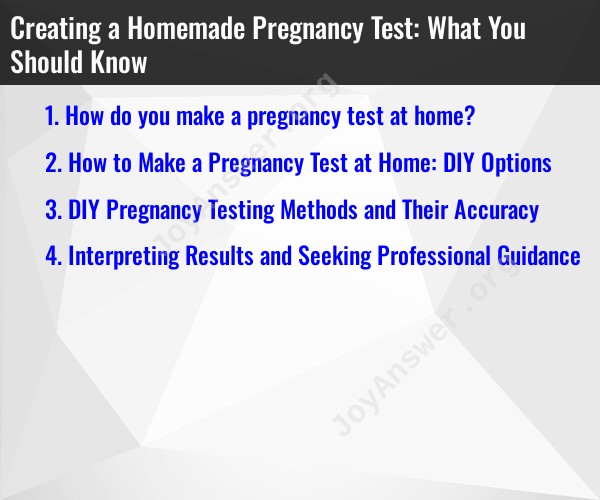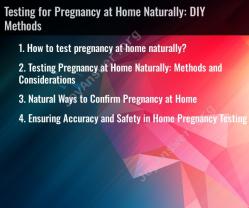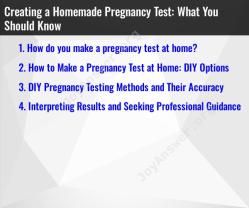How do you make a pregnancy test at home?
Creating a homemade pregnancy test is not recommended, as it may not be reliable or accurate. Over-the-counter pregnancy tests are designed to provide accurate results, and homemade tests are not a substitute for them. However, if you're in a situation where you can't access a store-bought pregnancy test and are curious about DIY methods, here are a couple of common homemade pregnancy tests that people have used in the past. Please note that the accuracy of these tests is questionable, and it's always best to consult a healthcare professional for a reliable result.
Toothpaste Test:
- Take a sample of your first-morning urine in a clean container.
- Add a small amount of white toothpaste (not a gel type) to the urine.
- Wait for a reaction. Some claim that the toothpaste will change in color or texture if you're pregnant, but this method is highly unreliable and not scientifically validated.
Sugar Test:
- Place a few spoonfuls of sugar in a clean, dry bowl.
- Urinate on the sugar.
- Wait for a few minutes. Some people believe that if the sugar clumps together, you might be pregnant, but this test is not reliable and lacks scientific evidence.
Bleach Test:
- Take a sample of your urine in a clear, plastic cup.
- Add some bleach to the urine.
- Wait for a reaction. Supposedly, if the mixture fizzes or produces a chemical reaction, it may indicate pregnancy. However, this is not a dependable method.
It's important to reiterate that these homemade pregnancy tests have no scientific basis and should not be relied upon for accurate results. Over-the-counter pregnancy tests are widely available, relatively inexpensive, and much more reliable. If you suspect you might be pregnant, it's best to use a reputable pregnancy test kit or consult a healthcare professional for a more accurate and reliable result. Home pregnancy tests typically work by detecting the presence of the hormone hCG (human chorionic gonadotropin) in your urine, and they are designed for this specific purpose.
How to Make a Pregnancy Test at Home: DIY Options
Disclaimer: DIY pregnancy tests are not as accurate as commercial pregnancy tests, and they should not be used as the sole basis for making decisions about pregnancy. If you have a positive result on a DIY pregnancy test, you should follow up with a doctor or other healthcare professional to confirm the result.
Here are a few DIY pregnancy testing methods:
- Sugar test: Mix equal parts sugar and urine in a clean container. If the sugar dissolves quickly, the result is negative. If the sugar clumps, the result is positive.
- Toothpaste test: Mix equal parts toothpaste and urine in a clean container. If the mixture turns blue or green, the result is positive. If it remains white, the result is negative.
- Baking soda test: Put a tablespoon of baking soda in a clean container and add a small amount of urine. If the baking soda fizzes, the result is positive. If it does not fizz, the result is negative.
DIY Pregnancy Testing Methods and Their Accuracy
The accuracy of DIY pregnancy tests is not well-studied, but they are generally thought to be less accurate than commercial pregnancy tests. Commercial pregnancy tests detect the presence of human chorionic gonadotropin (hCG), a hormone that is produced by the placenta after implantation. DIY pregnancy tests are based on a variety of different methods, and some of them may not be very reliable.
For example, the sugar test is based on the idea that hCG in urine can make sugar clump. However, other factors, such as the acidity of the urine, can also affect how sugar dissolves. The toothpaste test is based on the idea that hCG in urine can change the color of toothpaste. However, other factors, such as the type of toothpaste used, can also affect its color.
The baking soda test is based on the idea that hCG in urine can make baking soda fizz. However, other factors, such as the pH of the urine, can also affect how baking soda reacts.
Interpreting Results and Seeking Professional Guidance
If you get a positive result on a DIY pregnancy test, it is important to follow up with a doctor or other healthcare professional to confirm the result. A doctor can also perform other tests to rule out other medical conditions that may be causing your symptoms.
If you get a negative result on a DIY pregnancy test, but you are still concerned about the possibility of being pregnant, you should also follow up with a doctor. A doctor can perform a blood test to confirm or rule out pregnancy.
Conclusion
DIY pregnancy tests are not as accurate as commercial pregnancy tests, but they may be an option for people who do not have access to commercial tests or who cannot afford them. If you get a positive result on a DIY pregnancy test, you should follow up with a doctor or other healthcare professional to confirm the result. If you get a negative result on a DIY pregnancy test, but you are still concerned about the possibility of being pregnant, you should also follow up with a doctor.




